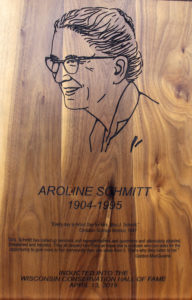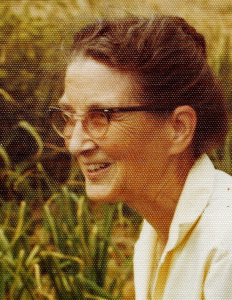1904 – 1995
Inducted 2019
“Mrs Schmitt has called up Senators and Representatives and Governors and alternately pleaded, threatened and heckled. They all respect her. They all know she is a citizen who just asks for the opportunity to give more to her community than she takes from it. That’s why they listen to her.” — Gordon MacQuarrie
As a citizen conservationist, Aroline Schmitt is a good example of how women have been instrumental in leading conservation crusades in Wisconsin and the nation. During the 1940 to the 1960s, she advanced the principles and practice of sustainable forestry, organized and led new conservation organizations, and worked hand-in-hand with many other conservation leaders. Despite health challenges, she fought with tenacity and charisma to advance major conservation policies affecting Wisconsin’s natural heritage.
She became a passionate champion for “Forest Conservation” at both the State and national level. Without formal training in forestry, she began her conservation work during World War II in what was then a man’s world, surveying and cruising timber lands for the US Forest Service in Alaska and the west. She continued in various roles with the Forest Service until 1961. She promoted the principles of sustainable forestry and timber management, before the practice was known by that name. She always prodded politicians, conservationists and industrial foresters to adopt good forestry practices.
Working with Gifford Pinchot (former Director of the U.S. Forest Service) and others, she also helped organize and served as Executive Secretary for a national conservation organization called “Forests” that advocated for wise forestry practices.
Her Wisconsin conservation efforts occurred from the 1930s to the 1960s. A frequent speaker and advocate for strong resource policy, she was a prolific letter writer and traveled around Wisconsin to participant in important meetings and legislative hearings. She worked armin-arm with conservation luminaries and fellow WCHF Indcutees including Aldo Leopold, William Aberg, and Wilhelmine La Budde.
 She also helped to organize and lead the Citizens Natural Resources Association and the conservation programs of the Wisconsin Garden Club Federation.
She also helped to organize and lead the Citizens Natural Resources Association and the conservation programs of the Wisconsin Garden Club Federation.
Schmitt played a pivotal role in protecting the Flambeau State Forest and its old growth hemlock-hardwood forests, and in the transfer of forested lands to the Wisconsin Conservation Commission (now WDNR). She also helped protect the Menominee Tribal Forest by lobbying for the rights of the Menominee Indians during a tense battle over termination of the tribe’s reservation status in the 1950s and 60s, and served as a consultant to the tribe until 1971.
Schmitt also helped establish several conservation facilities in Wisconsin, including the Trees for Tomorrow program in Eagle River, a Forest Service Camp at Trout Lake, and the Northern Forest Research Center in Rhinelander.
She produced a tremendous collection of correspondence including speeches, legislative testimony, letters to the editor, and personal letters with key conservation officials, both nationally and in Wisconsin. Her collected papers, now housed in the Wisconsin Historical Society Archive, are a goldmine of information on Wisconsin conservation issues from the 1940s to the 1960s.
She was recognized for her exemplary conservation work by, among others, the Citizens Natural Resources Association (Silver Acorn Award 1961), the Wisconsin Garden Club Federation (1956), and the Izaak Walton League (Broughton Award 1950).
For many years, due to persistent health problems, she fought her conservation battles from her bed and home office. With tenacity and dedication, she continued to influence conservation policy through her telephone calls, writings, and personal charisma.
Aroline Schmitt’s love for Wisconsin’s forests had deep family roots. Aroline was born into a wealthy family in Jamestown, New York, in 1904. Her grandfather, however, was a Wisconsin lumberman, who joined in the raid on Wisconsin’s timber in the 1800s, before the family moved east. Her mother was a botanist and passed on her love for nature and forests to her daughter.
Trained as a nurse, Aroline moved to Milwaukee in the 1920s to work for a doctor. Her husband, Max Schmitt, worked as a blueprint maker, while also fully supporting her passion for conservation. They lived with their two children in Wauwatosa. In the 1960s, she left Wisconsin for western states to be with family, but she left behind an important conservation legacy.
Resources
Family history notes from daughter Maxine Schmitt
Aroline Schmitt WCHF Induction Presentation, by Bill Berry 2019
Women’s History Month 2019 – Aroline Schmitt published by Accent on Natural Landscaping
Aroline Schmitt Pioneering Woman Conservationist Honored during Women’s History Month published in the Wisconservation page 4 by Wisconsin Wildlife Federation
Remembering conservation champion and citizen activist Aroline Schmitt, by Bill Berry
Letters to Aroline Schmitt from Aldo Leopold and Gifford Pinchot
Women in Conservation Article (includes WCHF Inductees Wilhelmine La Budde, Sigurd Olson and Pearl Pohl)
Garden Clubs of State Honor Mrs. Schmitt article
Silver Acorn Award Program, (includes Inductees William J. P. Aberg and E. M. Dahlberg), 1961
Mrs. Schmitt’s Garden Club Work leads to Tree-saving Activity by Margaret March-Mount, 1947 article
Plucky Mrs. Max Schmitt Does More Than Share for Exposition article
Milwaukee Journal Pays Tribute to Mrs. Max J. Schmitt of Wauwatosa, article, 1950
Illness a Spur Rather Than a Curb to Ambitious Milwaukee Conservationist article
Flambeau Land and Timber by Aroline Schmitt, 1950 article
Woman Gets Broughton Pin, article, 1950
Notes to Conservation Commission by Aroline Schmitt
Against Morning Dove Hunt by Aroline Schmitt
Tree Planting Letter written by Aroline Schmitt and Wilhelmine LaBudde (WCHF Inductee), 1942
Photos
These images may be used under the Creative Commons Attribution-NonCommercial-NoDerivatives 4.0 International License.









